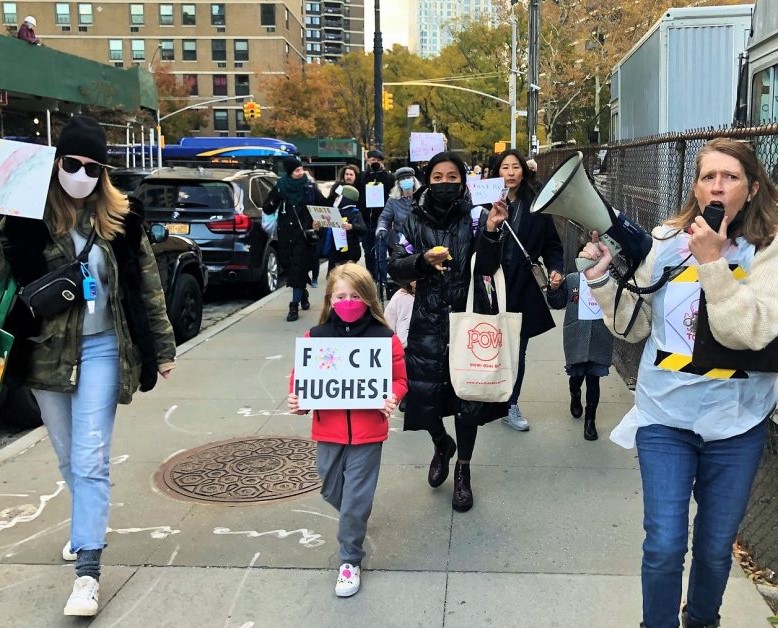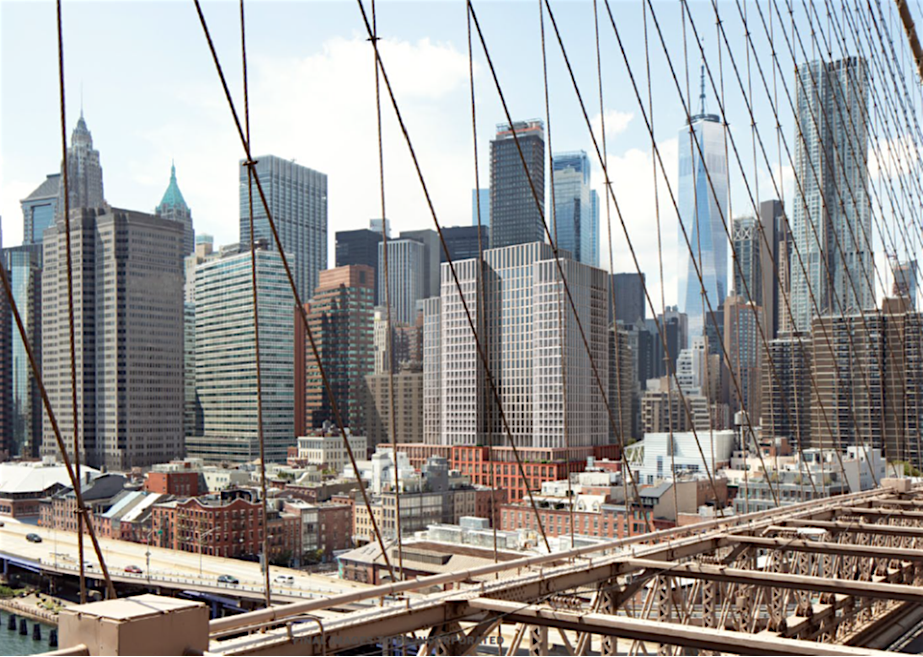BY WILL THOMAS | I write as a fellow resident of Lower Manhattan, one who welcomes in many ways how the Seaport and the Financial District more broadly have grown and changed over the course of the last few decades.
What used to be a place that closed up shop at the end of the workday has been transformed into a vibrant 24/7 community, with new restaurants and small businesses, and where more people each year can live, work and choose to raise their families.
But not everyone seems to think this should continue. Instead of seeing the area growing, some want to leave lots vacant. Instead of inviting new neighbors into our community, some prefer that others be priced out by soaring housing costs. Instead of investing in our recovery after the ravages of the pandemic, some insist that nothing further needs to be done.
At least, that’s what you’re forced to conclude from the publicly stated positions from opponents of new housing at 250 Water St. Currently a parking lot, the site near the South Street Seaport is set to be turned into an apartment building with 280 new homes, with more than 70 of them designated as affordable housing.
The opponents of 250 Water St. can’t seem to get their story straight as to why they are so vociferously opposed to a relatively modest 24-story apartment building. Some complain that the project is “architecturally inappropriate” given its height, even though it would sit mere blocks away from some of the tallest buildings in the city, which soar hundreds of feet higher.
Others insist that excavation at the site could pose health risks to residents, given its past use as a thermometer factory — even though the New York State Department of Health and Department of Environmental Conservation have signed off on cleanup plans that they’ll oversee.
Still others claim that they don’t want their neighborhood exploited for profit by the Howard Hughes Corporation, which is developing the site, as though building affordable housing is some sort of cash grab.

Most cynical of all, though, have been the opponents who are trotting out their own children as the purported victims of a 45 percent increase in affordable housing in their neighborhood. At a recent public protest against the project, one child was carrying a sign that read “F— Hughes.” Perhaps that child’s parents could visit some of the New York families who desperately need affordable housing options, and explain why their children don’t deserve to live in the same neighborhood.
Certain parents have gone so far as to insist that their children need the streets and open spaces around the parking lot as a play area, a grim reminder of Lower Manhattan’s dearth of parks and green spaces. Why then do some opponents of housing at 250 Water St. propose converting the site to an N.Y.P.D. tow pound instead? The traffic, noise and pollution from a police tow pound don’t seem like they would make for a good place for children to play.
The addition, the housing at 250 Water St. has been approved by the City Planning Commission and Landmarks Preservation Commission and is supported by current City Councilmember Margaret Chin. As anyone who follows these kinds of things knows, getting city agencies, elected officials and the companies that build housing on the same page is no mean feat.
But incoming Councilmember Christopher Marte, who will replace the term-limited Chin, is staunchly opposed to the project. He insists that he is “not going to let Howard Hughes do anything in this district unless they protect our residents.” At least Marte is being direct: His district includes some of the wealthiest zip codes in the state, and he’s simply putting these rich residents ahead of people who need affordable housing. If that means fighting for a parking lot in Lower Manhattan instead of 280 new homes, so be it.
Perhaps Marte is worried that if more people are able to live in Lower Manhattan, they may not be kind at the ballot box to politicians like him who have worked desperately to keep them out. One wonders what sort of zoning Marte and his allies would have proposed for Ellis Island, which is also in his district; maybe that should have been a tow pound, too.
The fight over 250 Water St. distills New York’s housing woes down to their purest and most ridiculous. If we can’t build even modest amounts of new housing in one of New York’s densest, tallest, transit-rich neighborhoods, then where can we build it? How can we call ourselves welcoming, neighborly or future-minded if we won’t allow a few new families into our community?
We can’t let a few unserious and inconsistent parking lot advocates speak for the rest of Lower Manhattan in order to kill affordable housing projects. Instead, let’s break ground and get people into homes. Welcome to the neighborhood.
Thomas is executive director, Open New York. The group says it supports “more social housing, government-subsidized housing and market-rate housing.”


“Legally allowed” is an offensive argument given the ramifications of adhering to the current zoning laws that are the result of years of frankly racist NIMBYism. When a law or policy results in bad outcomes for the majority of its residents it should be changed! NYC is a great place to live but pulling up the ladder for those who have yet to arrive will kill the very energy of the city we love.
A reality check:
– No one is promoting a vacant lot over affordable housing.
– No one is insisting that nothing further needs to be done to invest in our city.
– An architecturally appropriate development in an historic district does not look for its character and scale outside its bounds; the unique character embodied in our special places would soon fall before all the development interests seeking to capitalize on such places for private gain. Maybe uncritical devotion to skyscrapers needs a reset?
– The contaminants in the 250 Water site landfill are not some made up fiction, but a real health threat if exposed – to all the youngsters who go to the schools that are less than 50 ft from the site, and to all the local residents, as well as the workers who will do the cleanup. It would be irresponsible for parents and nearby residents not to take an active role in ensuring a safe cleanup. Depending on agency guarantees has proved less than reliable in the past, so skepticism and activism are more than warranted.
– As for the tow pound idea – It was an idea worth consideration: a low-scale city facility situated in a flood zone, that was proposed with storm and flood management infrastructure below grade and needed green public space on the roof. Dismissive sneering shows; or perhaps a touch of snobbery as to where such a facility belongs.
– As for your drum-roll for affordable housing – please spare us all the real-estate pitch. Take your feet and your mouth over to 5 World Trade Center, and speak out with all of us who want real and significant affordable housing.
Diversity is one of the elements that makes our city so special. Yes – we would welcome affordable housing at 250 Water with open arms, and not as a prop to advance luxury development.
100% affordable housing at 5WTC is not a real idea. There’s no money for it. And if there was money for it that money could build more affordable housing elsewhere. If the money was there I could see the appeal from an equity perspective even if it wouldn’t be the most efficient use, but the money isn’t there so it’s a moot point. All the proponents of a 100% affordable tower at 5WTC are doing is standing in the way of 25% affordable housing and a balance of market rate housing that is also needed to promote housing affordability citywide.
The fact that you say the tow lot was an idea worth considering shows that you have no understanding of the housing crisis and no good faith interest in working to solve it.
Wait so the community doesn’t have a problem with a 120-ft building? Because I was told in another post that the issue was the mercury in the ground and that any development at all would poison the children. Was that not correct? Were the people saying that not being honest?
Les3025, are you serious? This community has worked very, very closely with DEC, Langan and the Health Dept. to ensure the safety of the Brownfirld cleanup to the point that we hired an environmental expert to oversee the process. If you would pay attention you would understand that the community doesn’t want the digging while the children are in school. Due to COVID the windows must stay open for airflow and digging toxins during school with the windows open doesn’t seem safe, does it. And by the way, they should tent the area as they dig. I assume you do not have children in either school, but parents do worry about the health of their children. Interesting that you don’t seem to care; all you care about is build at all cost. Shame on you!
I am being serious. I would point you to the comments in another post (https://thevillagesun.com/in-seaport-250-people-march-against-250-water-st-demand-safe-cleanup-of-toxic-site) where opponents of the project repeatedly say or imply that no development should happen because there is no way to safely remediate the site. So I guess those people are either uninformed or dishonest based on what you’re telling me.
It seems to me that opponents of the project will strategically adopt whatever arguments they think will stop the project at whatever point in time they are making the argument, not because they honestly believe those arguments. Which is a point this op-ed makes that I agree with.
Mr. Thomas professes to know and understand the issues around 250 Water St. which he obviously doesn’t. First of all the community against the HHC megatower has NO problem with constructing a residential building on the site but it should be 120 feet tall, which is the legal height allowed. Furthermore HHC should make it 100% affordable housing. That would be great. What the residents have a problem with is a 34-story tower for the wealthy, three times the allowable height. Bribing the Manhattan borough president with money for the museum and a small amount of affordable units, neither of which are in writing, or required, is reprehensible. So YIMBY’s who are in the pocket of real estate developers can spew nonsense and disinformation but we, the community, want what is legally allowed.
Totally agree with Linda.
Among all the different designs HHC showed, there was never a building design that was within the 120-feet height limit during the community presentations. This clearly shows that they consider themselves higher than us regular folks who abide by the law, just like their current building design.
This seems to be another article supported by HHC propaganda, spreading a bunch of wrong information for an audience that doesn’t live around, or won’t be affected by the HHC high-rise for the rich.
Good thing we have the power to change the law.